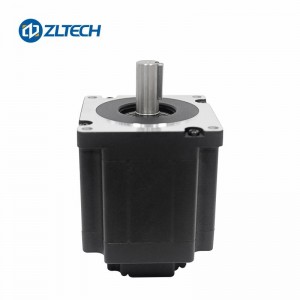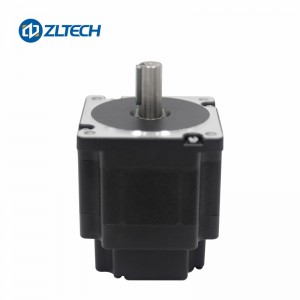BLDC Motor
-

ZLTECH 3phase 60mm Nema24 24V 100W/200W/300W/400W 3000RPM BLDC motor for printing machine
A Brushless DC Electric Motor (BLDC) is an electric motor powered by a direct current voltage supply and commutated electronically instead of by brushes like in conventional DC motors. BLDC motors are more popular than the conventional DC motors nowadays, but the development of these type of motors has only been possible since the 1960s when semiconductor electronics were developed.
Similarities BLDC and DC motors
Both types of motors consist of a stator with permanent magnets or electromagnetic coils on the outside and a rotor with coil windings that can be powered by direct current on the inside. When the motor is powered by direct current, a magnetic field will be created within the stator, either attracting or repelling the magnets in the rotor. This causes the rotor to start spinning.
A commutator is needed to keep the rotor rotating, because the rotor would stop when it is in line with the magnetic forces in the stator. The commutator continuously switches the DC current through the windings, and thus switches the magnetic field too. This way, the rotor can keep rotating as long as the motor is powered.
Differences BLDC and DC motors
The most prominent difference between a BLDC motor and a conventional DC motor is the type of commutator. A DC motor uses carbon brushes for this purpose. A disadvantage of these brushes is that they wear quickly. That is why BLDC motors use sensors – usually Hall sensors – to measure the position of the rotor and a circuit board that functions as a switch. The input measurements of the sensors are processed by the circuit board which it accurately times the right moment to commutate as the rotor turns.
-

ZLTECH 3phase 110mm Nema42 48V DC 1000W 27A 3000RPM brushless motor for robotic arm
Brushless DC motors are common in industrial applications across the world. At the most basic level, there are brushed and brushless motors and there are DC and AC motors. Brushless DC motors don’t contain brushes and use a DC current.
These motors provide many specific advantages over other types of electrical motors, but, going beyond the basics, what exactly is a brushless DC motor? How does it work and what’s it used for?
How a Brushless DC Motor Works
It often helps to explain how a brushed DC motor works first, as they were used for some time before brushless DC motors were available. A brushed DC motor has permanent magnets on the outside of its structure, with a spinning armature on the inside. The permanent magnets, which are stationary on the outside, are called the stator. The armature, which rotates and contains an electromagnet, is called the rotor.
In a brushed DC motor, the rotor spins 180-degrees when an electric current is run to the armature. To go any further, the poles of the electromagnet must flip. The brushes, as the rotor spins, make contact with the stator, flipping the magnetic field and allowing the rotor to spin a full 360-degrees.
A brushless DC motor is essentially flipped inside out, eliminating the need for brushes to flip the electromagnetic field. In brushless DC motors, the permanent magnets are on the rotor, and the electromagnets are on the stator. A computer then charges the electromagnets in the stator to rotate the rotor a full 360-degrees.
What are Brushless DC Motors Used For?
Brushless DC motors typically have an efficiency of 85-90%, while brushed motors are usually only 75-80% efficient. Brushes eventually wear out, sometimes causing dangerous sparking, limiting the lifespan of a brushed motor. Brushless DC motors are quiet, lighter and have much longer lifespans. Because computers control the electrical current, brushless DC motors can achieve much more precise motion control.
Because of all these advantages, brushless DC motors are often used in modern devices where low noise and low heat are required, especially in devices that run continuously. This may include washing machines, air conditioners and other consumer electronics.
-

ZLTECH 86mm Nema34 24-50VDC 3000RPM BLDC motor for engraving machine
PID speed & current double loop regulator
High performance & Low price
20KHZ chopper fequency
Electric brake function, which makes motor to respond quickly
The overload multiple is greater than 2, and the torque could always reach the maximum at low speed
With alarm functions including overvoltage, undervoltage, overcurrent, overtemperature, illegal hall signal and etc
-

ZLTECH Nema23 57mm 24V 35W/70W/100W/140W 3000RPM DC brushless motor for engraving machine
A BLDC motor with three coils on the stator will have six electrical wires (two to each coil) extending from these coils. In most implementations three of these wires will be connected internally, with the three remaining wires extending from the motor body (in contrast to the two wires extending from the brushed motor described earlier). Wiring in the BLDC motor case is more complicated than simply connecting the power cell’s positive and negative terminals.
The advantages of BLDC motor:
1. Efficiency. As these motors can control continuously at maximum rotational force (torque). Brushed motors, in contrast, reach maximum torque at only certain points in the rotation. For a brushed motor to deliver the same torque as a brushless model, it would need to use larger magnets. This is why even small BLDC motors can deliver considerable power.
2. Controllability. BLDC motors can be controlled, using feedback mechanisms, to delivery precisely the desired torque and rotation speed. Precision control in turn reduces energy consumption and heat generation, and—in cases where motors are battery powered—lengthens the battery life.
3. BLDC motors also offer high durability and low electric noise generation, thanks to the lack of brushes. With brushed motors, the brushes and commutator wear down as a result of continuous moving contact, and also produce sparks where contact is made. Electrical noise, in particular, is the result of the strong sparks that tend to occur at the areas where the brushes pass over the gaps in the commutator. This is why BLDC motors are often considered preferable in applications where it is important to avoid electrical noise.
We’ve seen that BLDC motors offer high efficiency and controllability, and that they have a long operating life. So what are they good for? Because of their efficiency and longevity, they are widely used in devices that run continuously. They have long been used in washing machines, air conditioners, and other consumer electronics; and more recently, they are appearing in fans, where their high efficiency has contributed to a significant reduction in power consumption.
-

ZLTECH 86mm Nema34 Nema34 36/48V 500/750W 19A 3000RPM BLDC motor for engraving machine
PID speed & current double loop regulator
High performance & Low price
20KHZ chopper fequency
Electric brake function, which makes motor to respond quickly
The overload multiple is greater than 2, and the torque could always reach the maximum at low speed
With alarm functions including overvoltage, undervoltage, overcurrent, overtemperature, illegal hall signal and etc.
Characteristics of brushless motor:
1) The motor is small in size and lighter in weight. For asynchronous motor, its rotor is composed of iron core with teeth and grooves, and the grooves are used to place induction windings to generate current and torque. The outer diameter of all rotors should not be too small. At the same time, the existence of mechanical commutator also limits the reduction of the outside diameter, and the armature winding of brushless motor is on the stator, so the outside diameter of the rotor can be relatively reduced.
2) The motor loss is small, this is because the brush is cancelled, and the electronic reversing is used to replace the mechanical reversing, so the friction loss and electric loss of the motor are eliminated. At the same time, there is no magnetic winding on the rotor, so the electric loss is eliminated, and the magnetic field will not produce iron consumption on the rotor.
3) The motor heating is small, this is because the motor loss is small, and the armature winding of the motor is on the stator, directly connected to the casing, so the heat dissipation condition is good, the heat conduction coefficient is large.
4) High efficiency. Although brushless motor is widely used and has a large power range, the application efficiency of different products is also different. In fan products, the efficiency can be improved by 20-30%.
5) the speed regulation performance is good, for the brushless motor through the potentiometer to adjust the voltage to achieve stepless or gear speed regulation, as well as PWM duty cycle speed regulation and pulse frequency speed regulation.
6) Low noise, small interference, low energy consumption, large starting torque, no mechanical friction caused by reversing.
7) High reliability, long service life, eliminating the need of brushes to eliminate the source of main motor faults, electronic commutator motor heating is reduced, motor life is extended.





